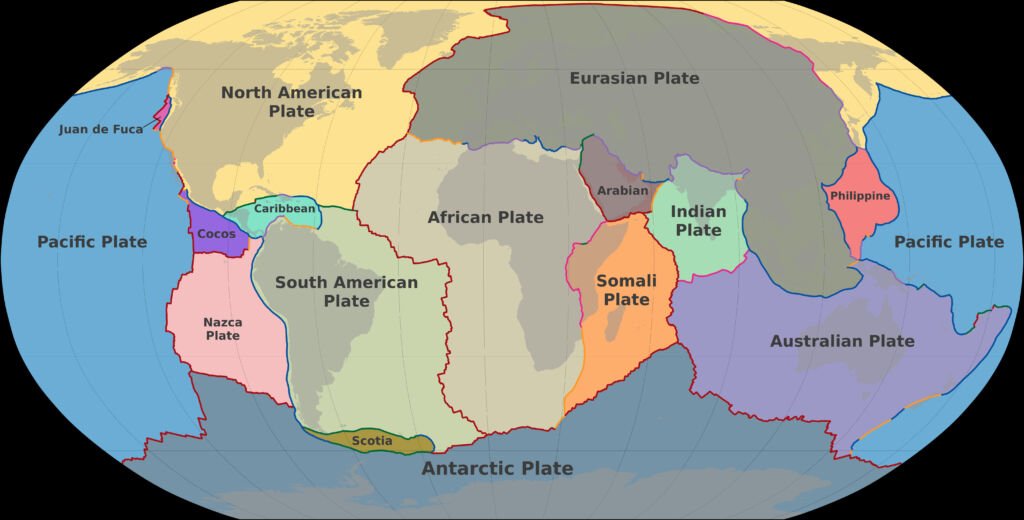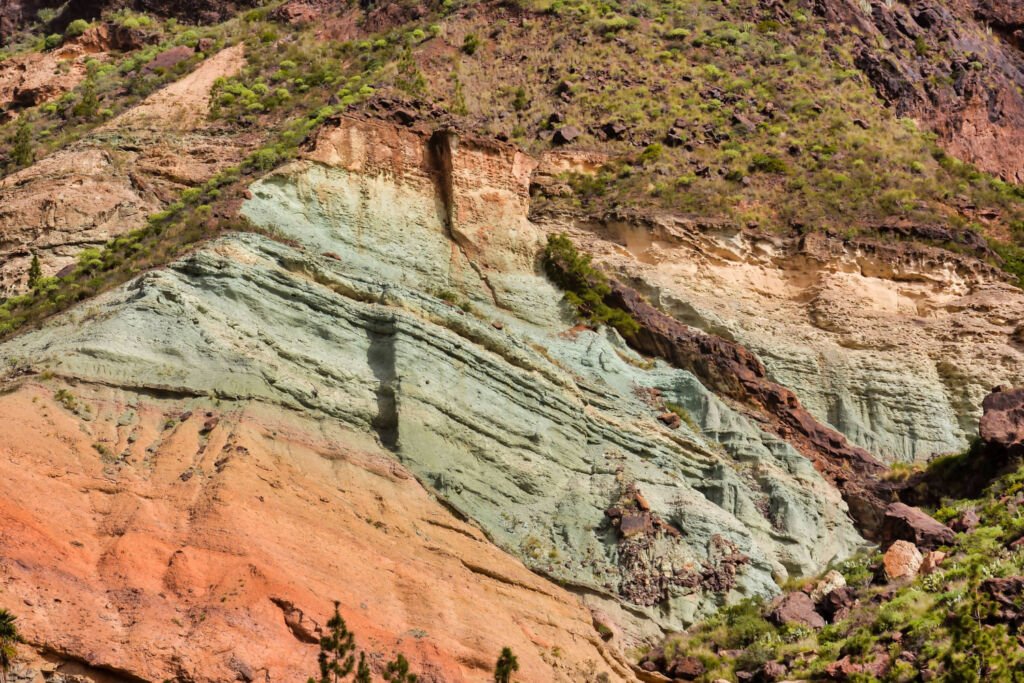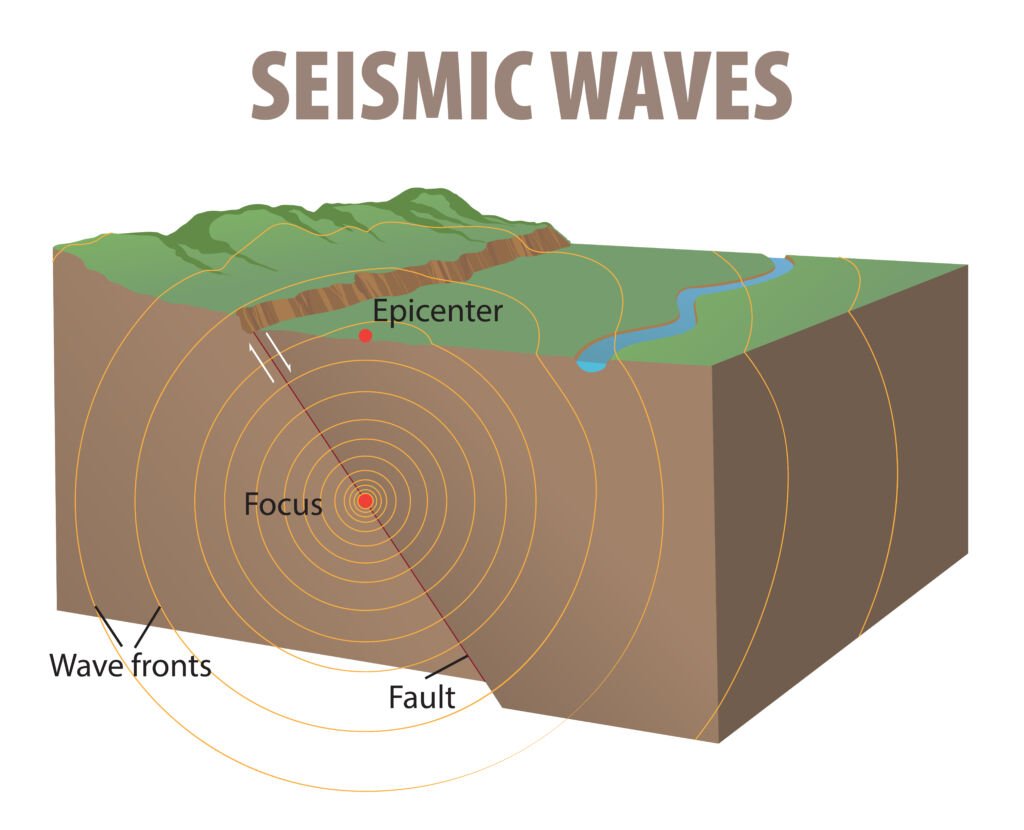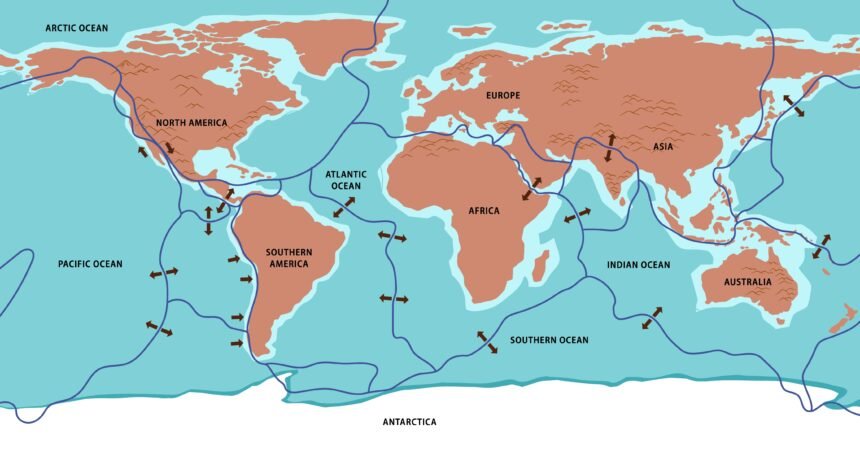Introduction:
Imagine a giant jigsaw puzzle, where the pieces are constantly moving, colliding, and grinding against each other. This isn’t just a metaphor; it’s the reality of our planet, thanks to the powerful forces of plate tectonics. These massive, invisible slabs of rock that make up Earth’s crust are the driving force behind everything from mountain ranges and earthquakes to volcanic eruptions and even the continents themselves.

Buckle up for a thrilling ride as we delve into the fascinating world of plate tectonics! We’ll explore the mind-blowing mechanisms behind this dynamic process, uncover its profound impact on our planet’s geography, and witness its awe-inspiring consequences that shape our world in dramatic ways.
What is Plate Tectonics?
Plate tectonics explains how the Earth’s outermost layer, known as the lithosphere, is broken into these immense, interlocking plates. The lithosphere consists of the Earth’s crust and the uppermost part of the mantle. These plates, averaging about 100 kilometers in thickness, float like rafts upon the more fluid mantle layer called the asthenosphere.
This Explanation Leads to why earthquakes and volcanic eruptions cluster near plate boundaries, or how a new ocean floor gets created – it all goes back to this basic picture of a cracked lithosphere “floating” on the asthenosphere.
What are the Driving Forces of the Plate Tectonics?
Convection in the Mantle:
The Earth’s core is immensely hot. This heat creates convection currents in the mantle, similar to the circular motion of boiling water in a pot.
Hot mantle material rises towards the crust, cools, and then sinks back towards the core, dragging the tectonic plates in a slow but powerful conveyor belt system.
Ridge Push:
At mid-ocean ridges (divergent boundaries), magma rises, creating a new oceanic crust. This new, hot crust is slightly elevated, forming a ridge.
This elevated crust gradually slopes downward and the force of gravity causes it to slide away from the ridge, “pushing” the rest of the older plate outwards.
Slab Pull:
At subduction zones (convergent boundaries), denser, usually oceanic, plates sink back into the mantle. The slab is cooler and therefore heavier than the surrounding material.
As the plate’s leading edge subducts, its weight pulls the rest of the plate along like an anchor sinking. This is considered one of the most powerful driving forces.
Other Contributing Factors (Under Debate):
Mantle Plumes:
Some scientists hypothesize that localized hotspots in the mantle, called mantle plumes, contribute to plate motion. These plumes might push plates at their base or weaken the crust above, making it easier for plates to move.
Tidal Forces:
The gravitational pull of the moon and sun on the Earth may play a minor role in Plate Tectonics.
The principles of the Plate Tectonics:
1. The Engine Beneath: It Starts With Heat
Earth’s Core: Inside the Earth, immense heat from the core and radioactive decay in the mantle sets the process in motion.
Convection Currents: This heat creates convection currents in the mantle, like a slowly boiling soup pot. Hotter, less dense material rises, while cooler, denser material sinks.
2. The Plates Get Moving
Conveyor Belt: The convection currents act like massive conveyor belts, dragging the lithospheric plates along with them.
Ridge Push: At spreading centers (divergent boundaries), new crust is created, pushing older crust further away like a slow-motion assembly line.
Slab Pull: At subduction zones (convergent boundaries), one plate slides under another, and its sinking weight pulls the rest downwards.
3. When Plates Meet

Where the action happens plate boundaries define how plates interact, leading to Earth’s most dramatic geological events.
Divergent Boundaries: Plates move apart. Molten rock from the mantle rises to fill the gap, creating a new oceanic crust (like the Mid-Atlantic Ridge).
Convergent Boundaries: Plates collide. This leads to the Ocean-Continent: A Denser oceanic plate subducts under the continent, creating volcanoes and mountain ranges (ex, Andes Mountains).
i) Ocean-Ocean: One plate subducts, forming deep ocean trenches and island arcs (ex: Japan).
ii) Continent-Continent: Massive uplift forms folded mountains (ex: the Himalayas).
iii) Transform Boundaries: Plates slide past each other horizontally. Stored stress along these boundaries is released as earthquakes (ex: San Andreas Fault).

4. Shaping the Earth Over Time
Slow but Powerful: Plate movements average a few centimeters a year, about the pace your fingernails grow. But over geological timescales, this adds up!
Continents Drift: This process explains continental drift – the continents were once a single landmass and have gradually shifted to their current positions.
Landscape Creation: Mountain ranges rise, volcanoes erupt, ocean basins open and close – plate tectonics creates and destroys features on a grand scale.
Types of Plate Boundaries:
The places where tectonic plates meet are known as plate boundaries. There are three main types of boundaries, each with its fascinating geological phenomena:
Divergent Boundaries: Here, two plates are moving away from each other. As they pull apart, magma (molten rock) from the mantle rises to fill the gap, creating a new oceanic crust. Iceland’s Mid-Atlantic Ridge, a classic example of a divergent boundary, constantly manufactures new seafloor, gradually widening the Atlantic Ocean.
Convergent Boundaries: Here, two plates collide. If one plate is denser (often an oceanic plate), it slides beneath the other in a process called subduction. This produces deep ocean trenches and generates magma that can fuel volcanic eruptions. The dramatic mountain ranges of the Andes and the Himalayas were formed in convergent boundaries.
Transform Boundaries: Here, plates slide past each other horizontally. The energy buildup along these boundaries is released in the form of earthquakes. California’s infamous San Andreas Fault is a well-known example of a transform boundary.
World-Shaping Effects:
The movement of tectonic plates is relentless, though remarkably slow – only a few centimeters per year. Over millions of years, these slight shifts have had monumental effects:
Creation of Continents:
The concept of continental drift, where the Earth’s continents were once joined together in a supercontinent called Pangaea, finds its explanation in plate tectonics.
Ancient Assemblages: Our familiar continents are puzzle pieces built by plate tectonics. Over hundreds of millions of years, smaller landmasses have collided and welded together, eventually breaking apart and rearranging into new configurations.
Continental Foundations: At the heart of continents often lie old, stable cratons – the leftover cores from tectonic processes of the distant past. These ancient continental sections have been built upon mountain ranges and new crusts created throughout Earth’s history.
Mountain Building:
Plate collisions form immense mountain ranges. The collision of India and Asia Plates gave rise to the tallest mountains on Earth, the Himalayas

Convergent Collisions: The most majestic mountain ranges are born where plates collide. The crumpling and uplift of the Earth’s crust in these tectonic battles produce breathtaking peaks like the Himalayas and the Andes.
Volcanic Arcs: Where oceanic plates descend beneath others, volcanoes form explosive chains. The Pacific “Ring of Fire” is a perfect example, dotted with hundreds of volcanoes linked to subduction zones.
Birth and Growth of Oceans:
Seafloor Spreading: At mid-ocean ridges, Earth’s crust spreads apart, with molten magma forming new seabed. This pushes out the older crust, eventually being recycled back into the mantle at subduction zones. This process steadily widens oceans like the Atlantic.
Ocean Demise: Just as oceans are born, they can also close. Oceanic crust, being denser, may eventually sink beneath the continental crust, leading to its destruction and the narrowing of an ocean basin.
Earthquakes, Volcanoes, and Tsunamis:
Plate boundaries are areas of concentrated seismic and volcanic activity due to the release of built-up pressure or from the rising magma.
Tectonic Stresses: Energy builds up along plate boundaries as they grind, snag, and collide. This stored energy is suddenly released as earthquakes, some catastrophic in magnitude.

Mega-Waves: Large earthquakes beneath the ocean floor can displace massive amounts of water, triggering devastating tsunamis that race across ocean basins.
Other Important Roles:
Mineral Deposits: Plate tectonic processes concentrate valuable metals and minerals. Volcanic activity can create rich ore deposits, while the uplift of mountains exposes other essential materials.
The Carbon Cycle: Over vast timescales, subduction carries carbon-containing sediments from the ocean floor back into the mantle. This helps regulate Earth’s long-term climate.
A Changing Habitat: Moving continents have dramatically shifted landmasses, ocean currents, and climate patterns throughout history, profoundly influencing the evolution and distribution of life.
Isolation and Adaptation: Separated continents act as natural ‘laboratories’ for evolution, leading to the incredible diversity of organisms we see today.
Conclusion:
Plate tectonics is a relatively recent scientific theory, solidified in the 1960s. It fundamentally changed our understanding of how the Earth works. Through plate tectonics, we now explain a seemingly disparate set of phenomena ranging from earthquakes to ocean formation.
Studying plate tectonics holds keys to predicting future seismic and volcanic hazards, providing a deeper understanding of our planet’s dynamic past, and perhaps even offering insights into the potential for Earth-like plates on other worlds.

